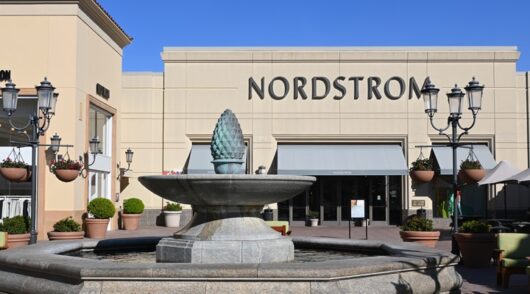Third-party sellers dominate digital commerce, capturing a staggering 57 per cent of global sales last year. Research suggests marketplaces are poised to become the largest and fastest-growing retail channel by 2027, adding over $1.3 trillion in sales.
Yet many brands in the US still seem reluctant to embrace the channel, especially those that have traditionally relied on D2C, whether through physical stores or their own brand.com sites, explains Daniel Hillyer. As VP of sales at Cymbio, Hillyer was talking to Inside Retail’s Amie Larter in an episode of the podcast Retail Untangled, recorded during Shoptalk Fall show in Chicago.
“These brands face massive amounts of new competition and rising acquisition costs, especially around social media channels like Facebook, Instagram and TikTok. It has become more and more expensive to retain, acquire and retain customers every year,” he continues.
“On the flip side, we see a pretty big shift in the traditional wholesale model, where brands that had relied on the annual buys from retailers are in flux.”
A lot of brand sales teams are struggling to match the same orders, he says, as retailers look to de-risk a lot of their business by reducing bulk orders that leave them shouldering the risk of inventory and moving the risk back to the brands. Five or 10 years ago, brands had a lot more power, but today, it has shifted more to the retailers.
With Covid came the explosion of marketplace and dropshipping models and hybrids between those. There are thousands of marketplaces worldwide across many verticals, with more opening every month. Cymbio, an all-in-one digital growth platform, works with brands to manage and automate processes, operations, and collaborations with marketplaces and traditional retail and social commerce partners.
Three key advantages of marketplaces
Hillyer says brands typically see three opportunities within marketplaces. First, they want to elevate their brand by reaching different audiences or changing the brand perception – perhaps even to a level where they can charge higher prices. He cautions the importance of choosing a marketplace whose consumer perception aligns with the brand.
The second opportunity is for retailers struggling with declining D2C or wholesale revenue. Marketplaces can generate additional revenue quickly, whereas closing a new wholesale deal can take two years. Marketplaces allow you to use inventory already in stock, and you don’t have to ship products in bulk.
Thirdly, many brands want to be in wholesale because it provides a predictable revenue stream, even though the margins may be lower than with D2C or a marketplace. It’s not easy – especially for some tier two or three brands – to have large wholesale deals with top retailers. “Marketplaces provide a brand with a way to prove to retailers that you are worthy, that there is demand, and that you align with their customer base. When retailers see certain SKUs and categories performing better, they will likely make a big purchase the following year.”
Appealing to new demographics
With an ageing population, legacy brands often face the challenge of maintaining volumes, so they need to find ways to reach younger audiences. Marketplaces can help here, he advises.
“Nobody wants to become a brand that is no longer cool or in trend. The key to being perceived as a hot brand – an interesting and sexy brand – is to be aligned with the best and hottest places.” Those might be TikTok Shop, Nordstrom, Saks, or Farfetch. “The ability and speed to adapt and sell in different marketplaces will help brands stay relevant and be perceived as attractive.”
Hillyer says new marketplaces are popping up constantly, and the space will continue to evolve rapidly because of the ease of onboarding new brands.
“Every brand and every retailer is or needs to be thinking about diversification. You cannot put all of your eggs in one basket. You cannot base your entire growth on D2C, brick-and-mortar, or wholesale – it has to be a combination. That’s why we will see marketplaces continue to grow; ultimately, brands have to rely on every channel that will allow them to improve their brand perception and increase sales.”
Roadblocks to overcome
One of the roadblocks to brands joining marketplaces is their culture, says Hillyer. “We’ve seen this forever in retail: brands that have held on too long to traditional and antiquated tactics and have paid the price. We still see brands that think they shouldn’t explore new means because their old ways are working well enough, and they don’t realize that they’re losing market share and their consumers’ behaviors are changing while they idle behind.”
Brands have to make a cultural shift, he says, and plan for the future by aligning with shifting consumer trends.
Another challenge is the lack of understanding and knowledge about the space, which is shifting quickly with channels like TikTok Shop and Shein – brands they might never have considered a few years ago but now have to because they are the future, says Hillyer.
“Shoppers are shopping in new ways. They’re shopping via interactive video and not via the traditional way of visiting a store or interacting with their website. So, brands have to keep up with these trends, and it’s not easy for them to know where their consumers are today and where they will be in the future.”
Another roadblock Hillyer cites is that retailers often do not know how to get on board new channels: Issues like legal or tax considerations, for example.
“Many of these brands need help and expertise from other brands or technology vendors that have been in this space for a while.”
- Listen to the Retail Untangled podcast to hear Hillyer sharing strategies for brands looking to join marketplaces and transact across borders – and why dropshipping is losing popularity.






